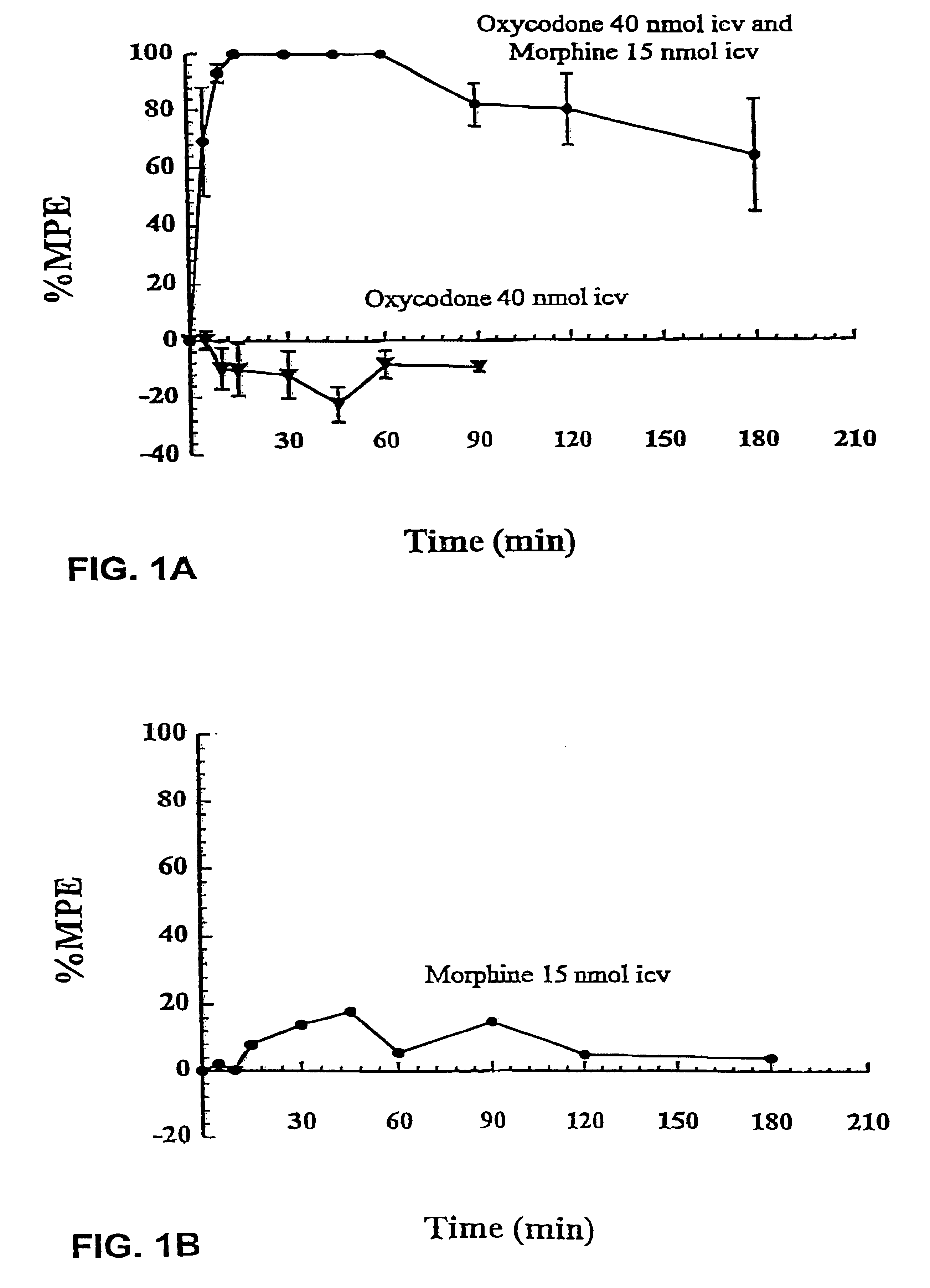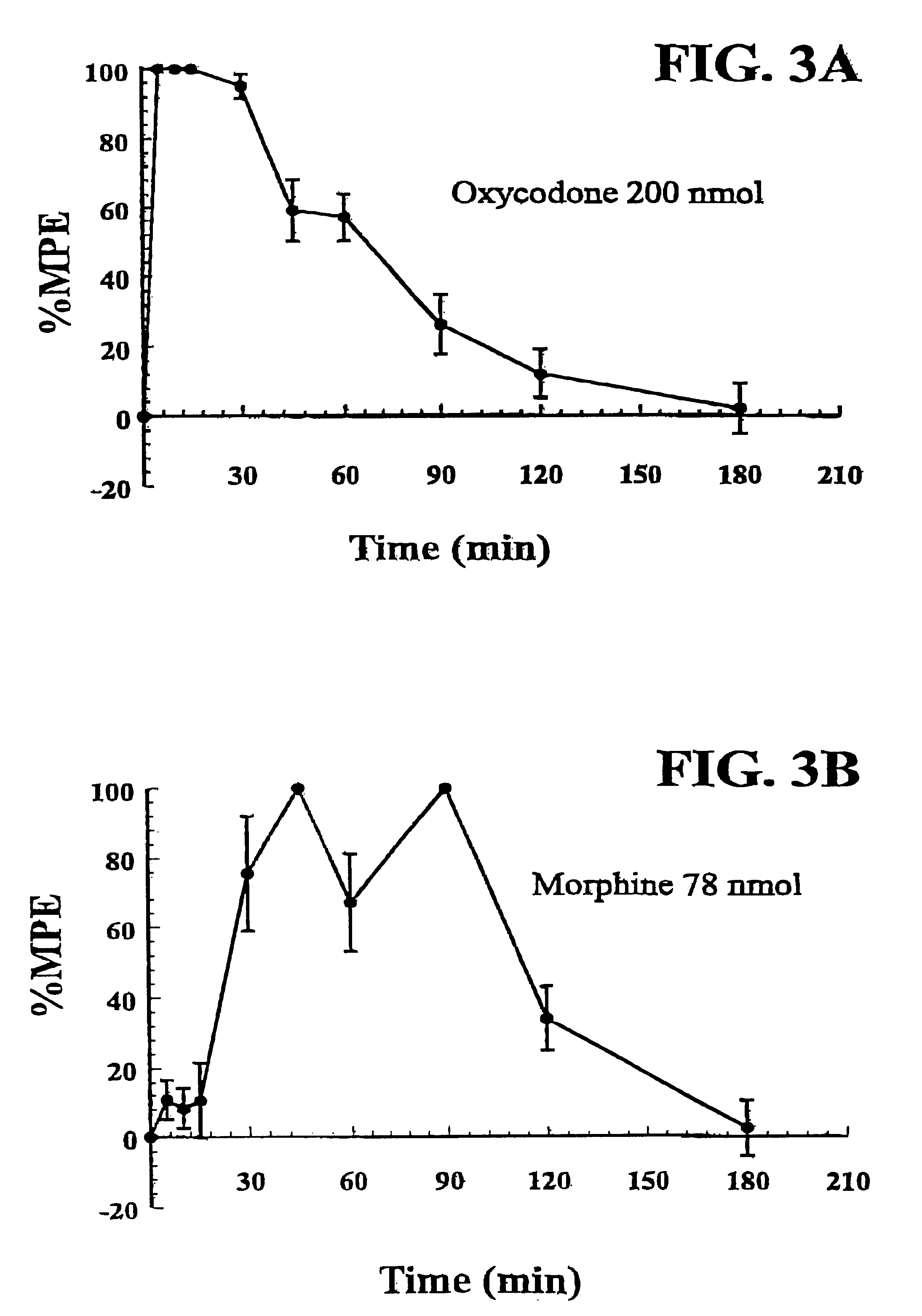Production of analgesic synergy by co-administration of sub-analgesic doses of a MU opioid agonist and a kappa-2 opioid agonist
a technology of opioid agonist and sub-analgesic dose, which is applied in the direction of heterocyclic compound active ingredients, drug compositions, biocide, etc., can solve the problems of inability to adequately control pain over the required time period, inability to address tolerance and/or dependence, and inability to administer narcotic analgesics at the end of the term, so as to achieve high analgesic potency and reduce the tendency
- Summary
- Abstract
- Description
- Claims
- Application Information
AI Technical Summary
Benefits of technology
Problems solved by technology
Method used
Image
Examples
example 2
The Intrinsic Antinociceptive Effects of Oxycodone Appear to Be Kappa-opioid Receptor Mediated
Oxycodone is a semi-synthetic opioid analgesic derived from the naturally occurring alkaloid, thebaine. In humans, oxycodone has been shown to have an analgesic potency 0.7 times that of morphine after systemic administration (Beaver et al., 1978, J. Pharmacol. Exp. Ther, 207, 92-100; Kalso et al., 1990, Pharmacol. Toxicol., 67, 322-328). Although oxycodone has been used clinically for over 75 years, little is known about the intrinsic pharmacology of this drug. Variously, oxycodone has been thought to induce analgesia by a similar mechanism to morphine or it has been proposed to be a prodrug for an analgesically active metabolite such as oxymorphone (Beaver et al., 1978, supra), its O-demethylated derivative. Oxymorphone is a potent .mu.-opioid receptor agonist with 10 times the potency of morphine (Beaver et al., 1977, J. Clin. Pharmacol., 17, 186-198). Recently, however, the putative rol...
example 3
Following intracerebroventricular (i.c.v) administration of oxycodone to adult male Sprague-Dawley (SD) rats, oxycodone elicits naloxone-reversible (i.e., opioid receptor-mediated), intrinsic pain-relieving (antinociceptive) effects with a potency equal to approximately half (44%) that of morphine administered by the same route (Leow, K. P. and Smith, M. T., 1994, supra). The studies described in Example 2, involving the i.c.v. administration of selective .mu.- .delta.- and .kappa.-opioid receptor antagonists, have shown that the intrinsic antinociceptive effects of oxycodone are completely attenuated by i.c.v. administration of the selective .kappa.-opioid receptor antagonist, nor-binaltorphimine (nor-BNI), in doses that did not attenuate the antinociceptive effects of i.c.v. morphine (.mu.-opioid agonist). Additionally, the .mu..sub.1 -opioid receptor antagonist, naloxonazine and the .delta.-opioid receptor antagonist, naltrindole, did not attenuate the antinociceptive effects of ...
example 4
Investigation of the Antinociceptive Effects of a Range of Subanalgesic Dosing Combinations of Morphine and Oxycodone Following Subcutaneous Administration to Dark Agouti Rats
The studies described in Example 1 showed that co-administration of subanalgesic doses of morphine and oxycodone by both the intracerebroventricular (i.c.v.) route to Sprague-Dawley (SD) rats and by the intraperitoneal (i.p.) route to Dark Agouti (DA) rats elicits marked antinociceptive synergy characterized by a significant increase in both the extent and duration of antinociception when compared with the expected levels of antinociception had only additive antinociceptive effects been achieved. Opioids are not administered by the i.p. route to humans. Rather, the subcutaneous (s.c.) route is the preferred systemic route of opioid drug administration for patients that have difficulty swallowing or that have intractable nausea and vomiting. Therefore, this study was designed to determine (i) the individual dose...
PUM
| Property | Measurement | Unit |
|---|---|---|
| Time | aaaaa | aaaaa |
| Time | aaaaa | aaaaa |
| Time | aaaaa | aaaaa |
Abstract
Description
Claims
Application Information
 Login to View More
Login to View More - R&D
- Intellectual Property
- Life Sciences
- Materials
- Tech Scout
- Unparalleled Data Quality
- Higher Quality Content
- 60% Fewer Hallucinations
Browse by: Latest US Patents, China's latest patents, Technical Efficacy Thesaurus, Application Domain, Technology Topic, Popular Technical Reports.
© 2025 PatSnap. All rights reserved.Legal|Privacy policy|Modern Slavery Act Transparency Statement|Sitemap|About US| Contact US: help@patsnap.com



